Comparison of the Sample Preparation Strategies and Impacts on the Tensile Strength of Gas Shale with Variable Moisture Conditions
Abstract
1. Introduction
2. Materials and Methods
2.1. Preparation Strategies of Samples with Different Saturation
2.2. Test Methods
3. Results
3.1. Relationship between Shale Tensile Strength and Saturation
3.2. Tensile Strength Dispersion
3.3. Relationship between Tensile Strength Degradation and Saturation
3.4. Failure Mode
3.5. Mechanism Analysis
4. Discussion
5. Conclusions
- (1)
- The soaking time when preparing the sample will affect the degradation effect of shale strength, that is, the longer the soaking time is, the higher is the strength degradation degree of the sample with the same moisture content. Therefore, in the process of studying the effect of different moisture contents on the tensile strength of shale, the effect of soaking time cannot be ignored.
- (2)
- Under the joint influence of moisture content and soaking time, the tensile strength of shale decreases approximately linearly with the increase in saturation. The degree of deterioration increases nonlinearly with the increase in saturation, and the growth rate increases from slow to fast.
- (3)
- In the process of sample preparation, the increase in soaking time will lead to the increase in dispersion of shale tensile strength, and may lead to the failure mode of the sample deviating from the Brazilian splitting theory model.
- (4)
- In order to reduce the strength deterioration caused by hydration when studying the effect of moisture content on shale strength, the soaking time should be reduced as much as possible when preparing the samples.
Author Contributions
Funding
Data Availability Statement
Conflicts of Interest
References
- Shen, D. China’s Energy Problem and Alternative Solutions. J. Contemp. China 2001, 10, 717–722. [Google Scholar] [CrossRef]
- Zou, C.; Pan, S.; Hao, Q. On the connotation, challenge and significance of China’s “energy independence” strategy. Pet. Explor. Dev. 2020, 47, 449–462. [Google Scholar] [CrossRef]
- Li, Y.; Zhou, D.H.; Wang, W.H.; Jiang, T.X.; Xue, Z.J. Development of unconventional gas and technologies adopted in China. Energy Geosci. 2020, 1, 55–68. [Google Scholar] [CrossRef]
- Geologists, P.O.A.A.; Division, M.E. Unconventional Energy Resources: 2015 Review. Nat. Resour. Res. 2015, 24, 443–508. [Google Scholar]
- Sieminski, A.; EIA Administrator. International Energy Outlook; U.S. Energy Information Administration: Washington, DC, USA, 2016.
- Wang, J.S.; Ryan, D.; Anthony, E.J. Reducing the greenhouse gas footprint of shale gas. Energy Policy 2011, 39, 8196–8199. [Google Scholar] [CrossRef]
- Mayerhofer, M.J.; Lolon, E.P.; Warpinski, N.R.; Cipolla, C.L.; Walser, D.; Rightmire, C.M. What Is Stimulated Reservoir Volume? SPE Prod. Oper. 2010, 25, 89–98. [Google Scholar] [CrossRef]
- Wang, D.B.; Taleghani, A.D.; Yu, B. Height Effect on Interactions between the Hydraulic Fracture and Natural Fractures. Geofluids 2022, 2022, 4642326. [Google Scholar] [CrossRef]
- Hubbert, M.K.; Willis, D.G. Mechanics of Hydraulic Fracturing. Trans. Am. Inst. Min. Metall. Eng. 1957, 210, 153–168. [Google Scholar] [CrossRef]
- Haimson, B.; Fairhurst, C. Initiation and Extension of Hydraulic Fractures in Rocks. Soc. Pet. Eng. J. 1967, 7, 310–318. [Google Scholar] [CrossRef]
- Ito, T.; Hayashi, K. Physical background to the breakdown pressure in hydraulic fracturing tectonic stress measurements. Int. J. Rock Mech. Min. Sci. Geomech. Abstr. 1991, 28, 285–293. [Google Scholar] [CrossRef]
- Zhao, W.Z.; Hu, S.Y.; Hou, L.H. Connotation and strategic role of in-situ conversion processing of shale oil underground in the onshore China. Pet. Explor. Dev. 2018, 45, 563–572. [Google Scholar] [CrossRef]
- Li, H.; Lai, B.; Liu, H.H.; Zhang, J.L.; Georgi, D. Experimental Investigation on Brazilian Tensile Strength of Organic-Rich Gas Shale. SPE J. 2016, 22, 148–161. [Google Scholar] [CrossRef]
- Zheng, D.; Miska, S.; Ziaja, M.; Zhang, J. Study of anisotropic strength properties of shale. AGH Drill. Oil Gas 2019, 36, 93–112. [Google Scholar] [CrossRef]
- Zheng, D.; Ozbayoglu, E.; Miska, S.; Zhang, J. Experimental Study of Anisotropic Strength Properties of Shale. In Proceedings of the 57th US Rock Mechanics/Geomechanics Symposium, Atlanta, GA, USA, 25–28 June 2023. [Google Scholar]
- Teng, J.Y.; Tang, J.X.; Zhang, C. Experimental study on tensile strength of layered water-bearing shale. Rock Soil Mech. 2018, 39, 1317–1326. [Google Scholar]
- Roy, D.G.; Singh, T.N.; Kodikara, J.; Ratan, D. Effect of Water Saturation on the Fracture and Mechanical Properties of Sedimentary Rocks. Rock Mech. Rock Eng. 2017, 50, 2585–2600. [Google Scholar]
- Babets, D.V.; Kovrov, O.S.; Moldabayev, S.K.; Tereschuk, R.M. Impact of water saturation effect on sedimentary rocks strength properties. Nauk. Visnyk Natsionalnoho Hirnychoho Universytetu 2020, 2020, 76–81. [Google Scholar] [CrossRef]
- Hasbollah, A.Z.D.; Mohamad, T.E.; Hezmi, A.M.; Abdullah, R.A.; Yunus, N.Z.M.; Mustaffar, M.; Jusoh, S.N.; Azmi, M.; Ramli, M.H.; Taib, A.M. Comparison study on the strength index of tropical shale and sandstone influenced by moisture content. In Proceedings of the IOP Conference Series: Materials Science and Engineering, Kuala Lumpur, Malaysia, 27–28 February 2019. [Google Scholar]
- Lin, Y.F.; Guan, F.J.; Hu, H.Y. Adsorption Characteristics of Water-bearing Shale in Longmaxi Formation, Eastern Sichuang. J. Xi’an Shiyou Univ. (Nat. Sci. Ed.) 2019, 34, 21–25. [Google Scholar]
- Li, W.T.; Pour-Ghaz, M.; Castro, J.; Weiss, J. Water absorption and critical degree of saturation relating to freeze-thaw damage in concrete pavement joints. J. Mater. Civ. Eng. 2012, 24, 299–307. [Google Scholar] [CrossRef]
- Hatheway, W.A. The Complete ISRM Suggested Methods for Rock Characterization, Testing and Monitoring: 1974–2006. Environ. Eng. Geosci. 2009, 15, 47–48. [Google Scholar] [CrossRef]
- Xue, H.Q.; Zhou, S.W.; Jiang, Y.L.; Zhang, F.D.; Dong, Z.; Guo, W. Effects of hydration on the microstructure and physical properties of shale. Pet. Explor. Dev. Online 2018, 45, 1146–1153. [Google Scholar] [CrossRef]
- Wang, Q.; Lyu, C.; Cole, R.D. Effects of hydration on fractures and shale permeability under different confining pressures: An experimental study. J. Pet. Sci. Eng. 2019, 176, 745–753. [Google Scholar] [CrossRef]
- Liu, J.; Bai, X.; Derek, E. Evolution of pore systems in low-maturity oil shales during thermal upgrading—Quantified by dynamic SEM and machine learning. Pet. Sci. 2024, in press. [CrossRef]
- Liu, J.; Yao, Y.B.; Elsworth, D. Morphological complexity and azimuthal disorder of evolving pore space in low-maturity oil shale during in-situ thermal upgrading and impacts on permeability. Pet. Sci. 2024, in press. [CrossRef]
- Huang, Z.; Zhang, Y.; Xie, L.Z.; Zhao, P.; He, B.; Ren, L. Comparative study of porosity test methods for shale. Arab. J. Geosci. 2020, 13, 94. [Google Scholar] [CrossRef]
- Li, D.; Wong, L.N.Y. The Brazilian Disc Test for Rock Mechanics Applications: Review and New Insights. Rock Mech. Rock Eng. 2012, 46, 269–287. [Google Scholar] [CrossRef]
- Dodge, Y. The Concise Encyclopedia of Statistics; Springer Science & Business Media: New York, NY, USA, 2008; pp. 95–267. [Google Scholar]
- Yang, Z.P.; He, B.; Xie, L.Z.; Li, C.B.; Wang, J. Strength and failure modes of shale based on Brazilian test. Rock Soil Mech. 2015, 36, 3447–3455. [Google Scholar]
- Van, E.E.M. The mechanisms of strength reduction due to moisture in coal mine shales. Int. J. Rock Mech. Min. Sci. Geomech. Abstr. 1976, 13, 61–67. [Google Scholar]
- Chalmers, G.R.L.; Bustin, R.M.; Power, I.M. Characterization of gas shale pore systems by porosimetry, pycnometry, surface area, and field emission scanning electron microscopy/transmission electron microscopy image analyses: Examples from the Barnett, Woodford, Haynesville, Marcellus, and Doig units. AAPG Bull. 2012, 96, 1099–1119. [Google Scholar]
- Zhou, T.; Zhang, S.C.; Yang, L.; Ma, X.F.; Zou, Y.S.; Lin, H. Experimental investigation on fracture surface strength softening induced by fracturing fluid imbibition and its impacts on flow conductivity in shale reservoirs. J. Nat. Gas Sci. Eng. 2016, 36, 893–905. [Google Scholar] [CrossRef]
- Liu, X.J.; Zeng, W.; Liang, L.X.; Xiong, J. Experimental study on hydration damage mechanism of shale from the Longmaxi formation in southern Sichuan basin, China. Petroleum 2016, 2, 54–60. [Google Scholar] [CrossRef]
- Liang, L.; Xiong, J.; Liu, X. Experimental study on crack propagation in shale formations considering hydration and wettability. J. Nat. Gas Sci. Eng. 2015, 23, 492–499. [Google Scholar] [CrossRef]
- Yu, H.T.; Ding, Y.; Liu, Y.M.; Peng, M.; Liang, L.X.; Yu, X.L. A dynamical spontaneous imbibition model for shale considering hydration damage. Pet. Drill. Tech. 2023, 51, 139–148. [Google Scholar]
- Qian, B.; Zhu, J.H.; Yang, H.; Liang, X.; Yin, C.B.; Shi, X.Z.; Li, D.Q.; Li, J.L.; Fang, H. Experiments on shale reservoirs plugs hydration. Pet. Explor. Dev. 2017, 44, 615–621. [Google Scholar] [CrossRef]
- She, H.C.; Liu, S.Q.; Zhang, D.C.; Luo, K.; Hu, Z.Q. Research on Shale Hydration Disturbance Damage Test and Statistical Damage Model. Chin. J. Undergr. Space Eng. 2023, 19, 602–609. [Google Scholar]
- Li, J.P.; Lian, M.J. Mining Rock Mechanics, 2nd ed.; Metallurgical Industry Press: Beijing, China, 2011; p. 57. [Google Scholar]
- Shadizadeh, R.S.; Moslemizadeh, A.; Dezaki, S.A. A novel nonionic surfactant for inhibiting shale hydration. Appl. Clay Sci. 2015, 118, 74–86. [Google Scholar] [CrossRef]
- Chao, Z.M.; Wang, H.L.; Xu, W.Y.; Jia, C.J.; Zhao, K. A rapid method for preparing rock samples with different water saturation levels. Rock Soil Mech. 2018, 39, 1109–1114. [Google Scholar]


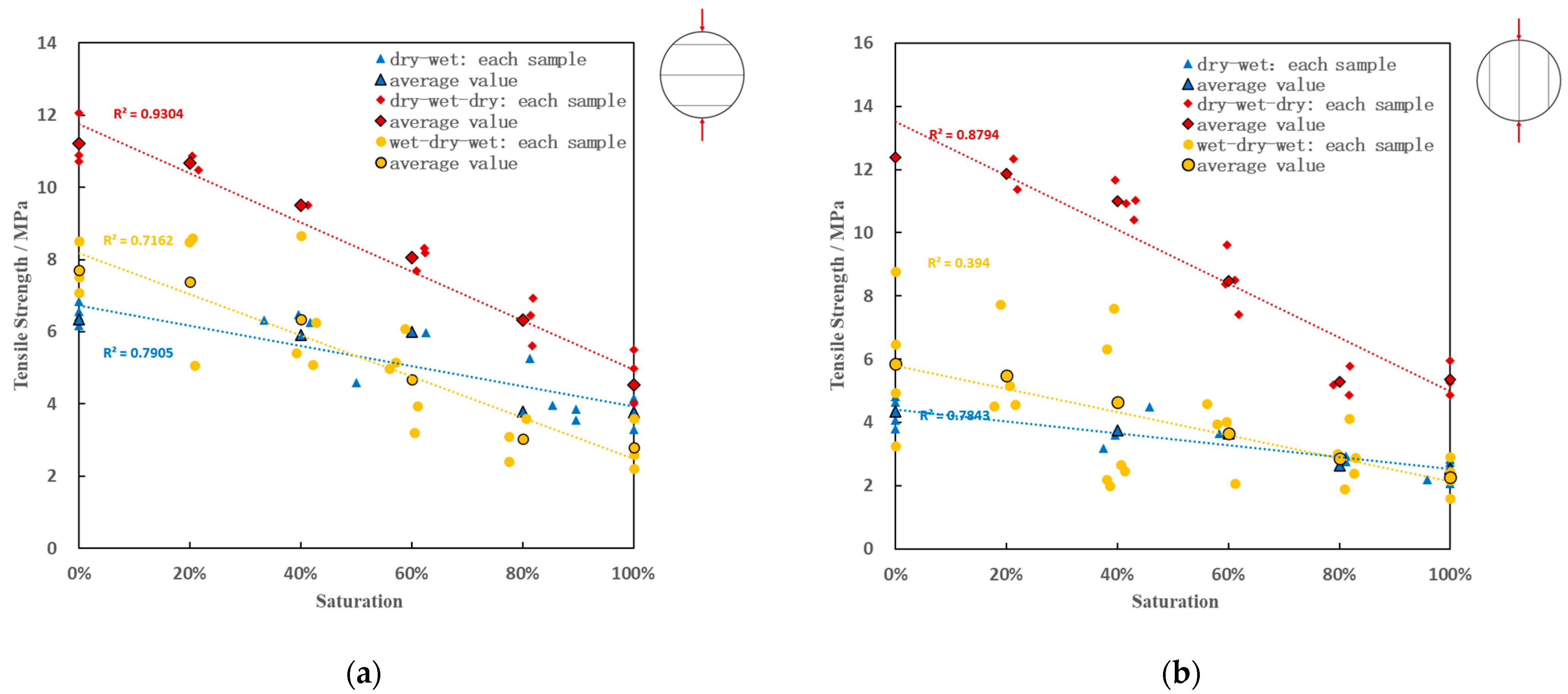
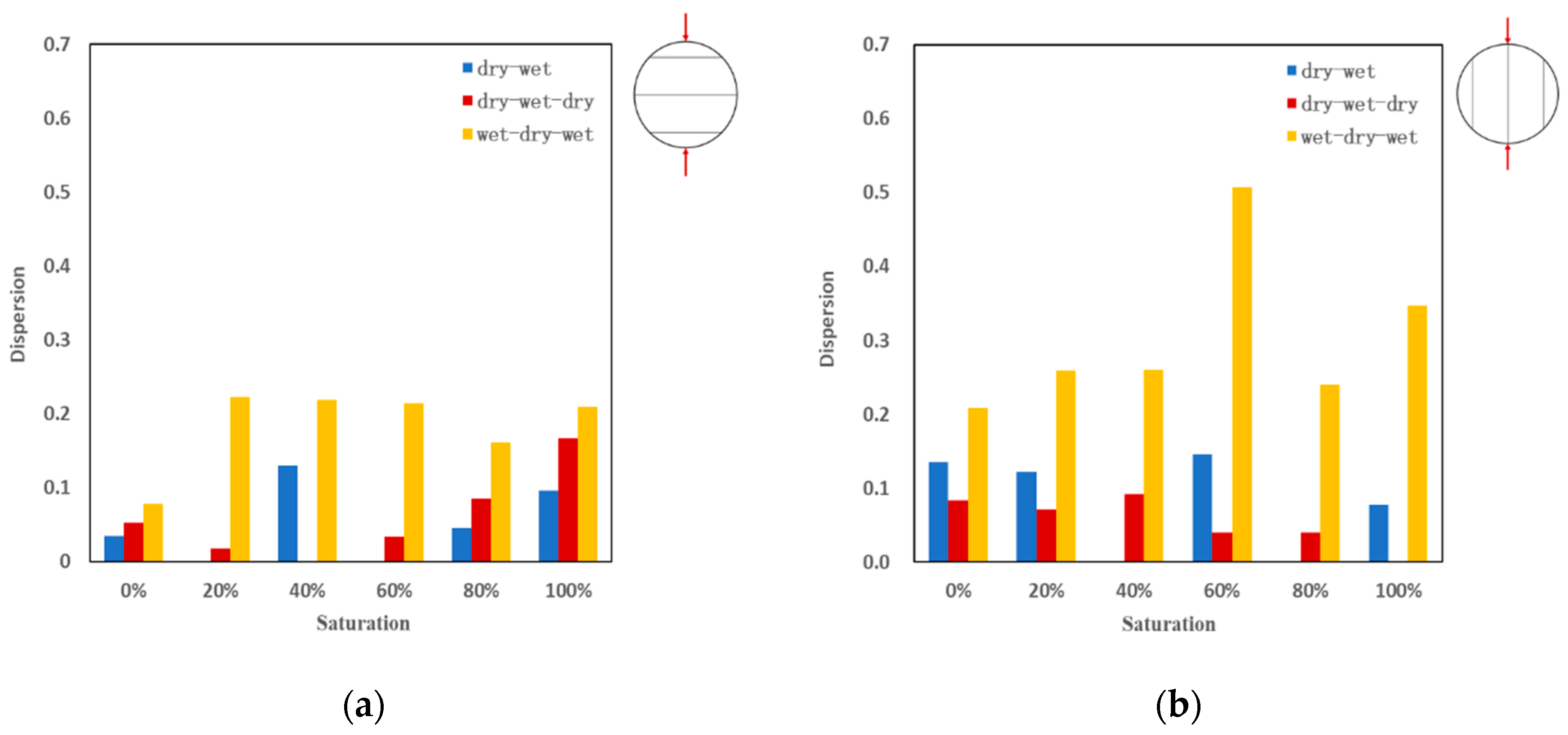

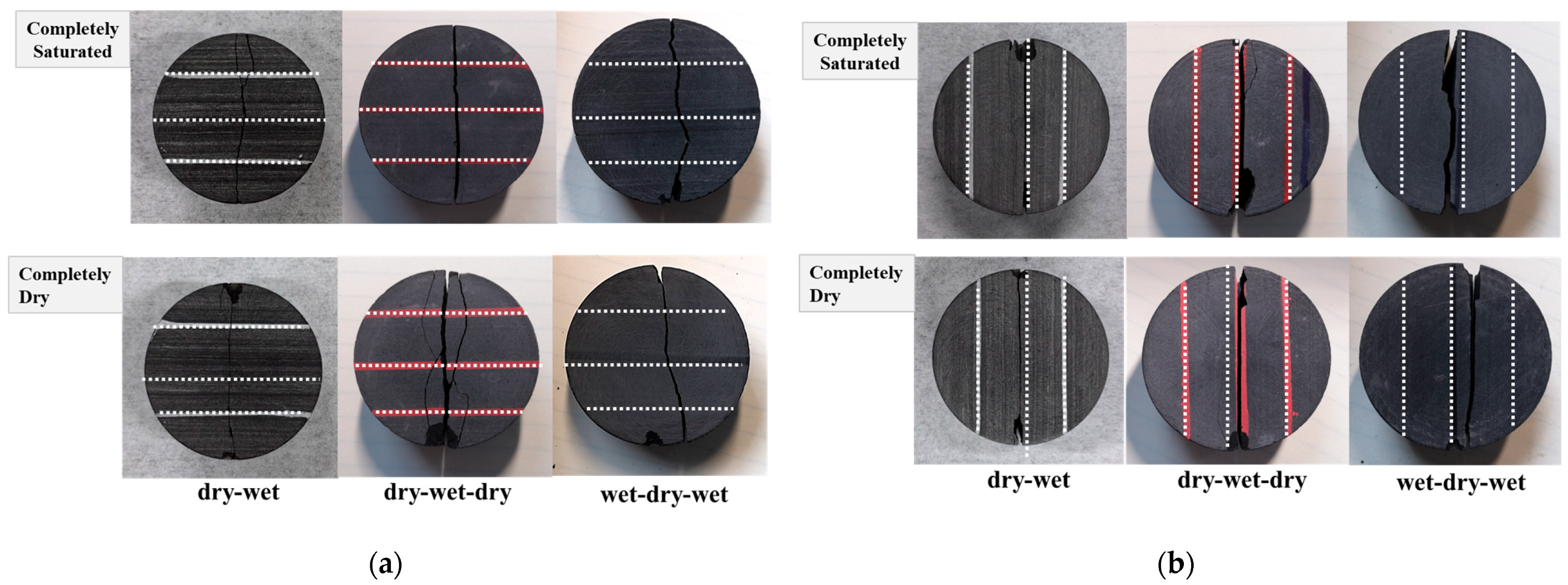

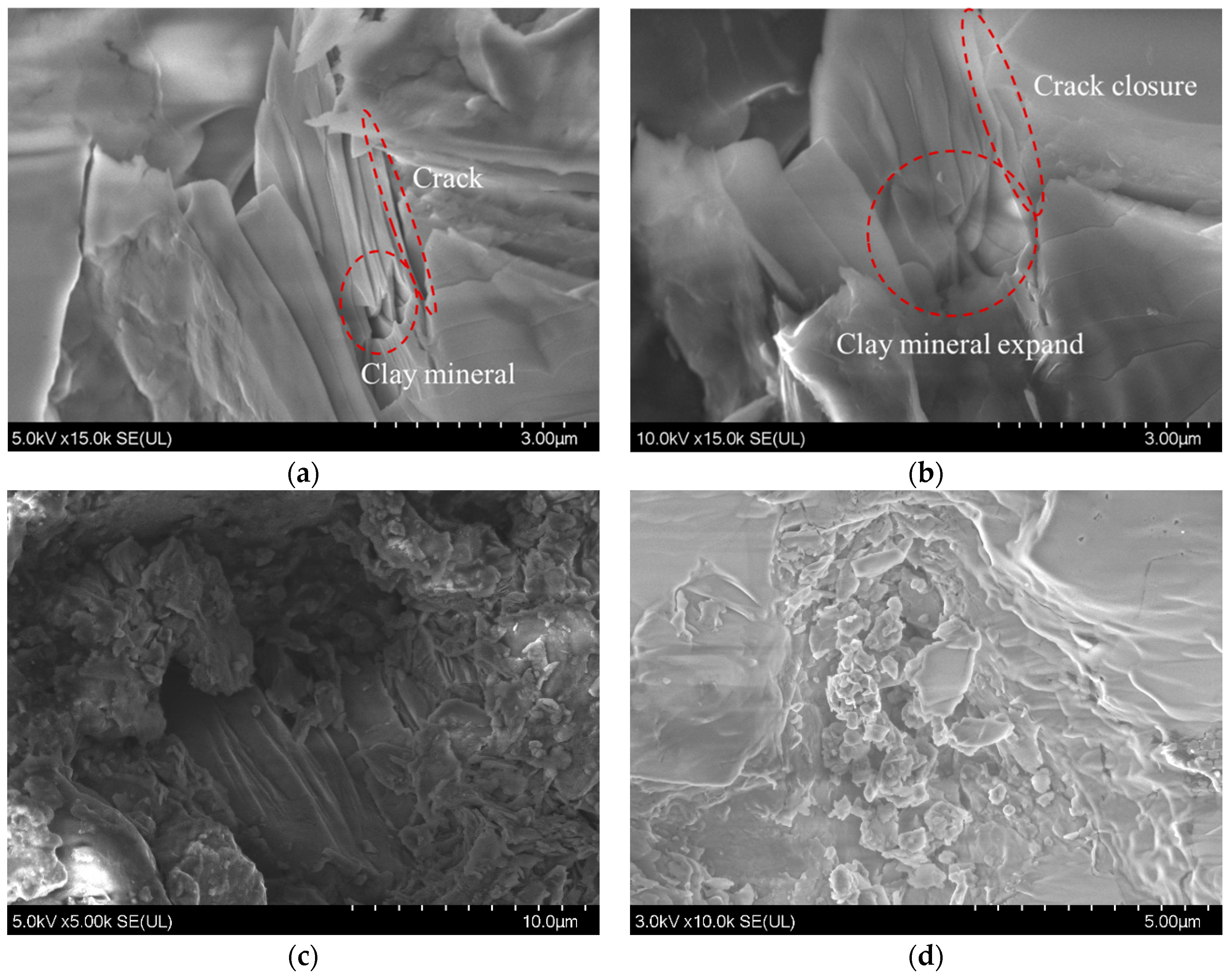
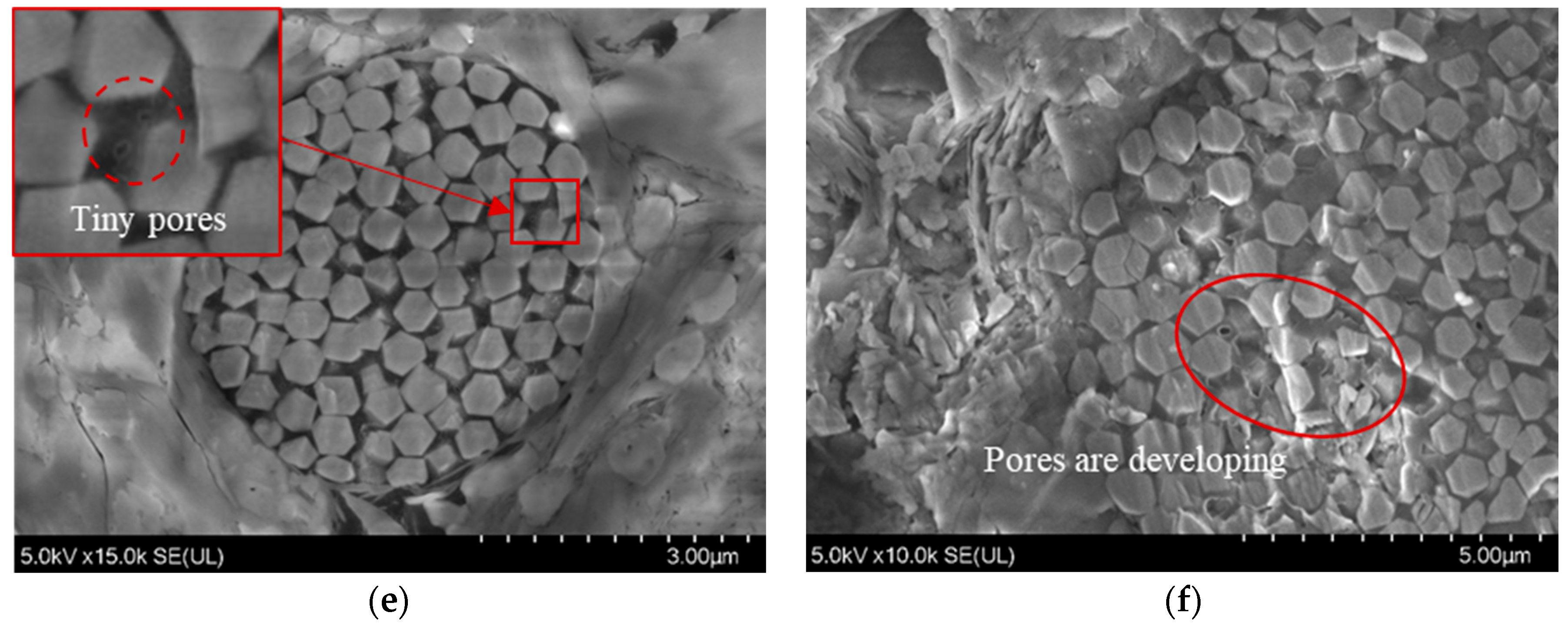
| Load Mode | Target Saturation | Preparation Strategies | ||
|---|---|---|---|---|
| “Dry-Wet-Dry” | “Wet-Dry-Wet” | “Dry-Wet” | ||
| Perpendicular to bedding | 0% | 3 | 3 | 5 |
| 20% | 2 | 3 | / | |
| 40% | 1 | 4 | 4 | |
| 60% | 3 | 5 | 2 | |
| 80% | 3 | 3 | 3 | |
| 100% | 4 | 3 | 3 | |
| Parallel to bedding | 0% | 2 | 4 | 6 |
| 20% | 2 | 4 | / | |
| 40% | 4 | 6 | 3 | |
| 60% | 4 | 4 | 1 | |
| 80% | 3 | 5 | 3 | |
| 100% | 3 | 4 | 3 | |
| Saturation | Perpendicular Bedding Loading | Parallel Bedding Loading | ||||
|---|---|---|---|---|---|---|
| “Dry-Wet” | “Dry-Wet-Dry” | “Wet-Dry-Wet” | “Dry-Wet” | “Dry-Wet-Dry” | “Wet-Dry-Wet” | |
| 100% | 40.8% | 59.6% | 63.6% | 41.4% | 57.4% | 61.1% |
| 80% | 40.3% | 43.6% | 60.5% | 39.5% | 31.6% | 51.2% |
| 60% | 11.5% | 28.2% | 39.4% | 15.6% | 11.1% | 37.5% |
| 40% | 6.9% | 15.3% | 17.5% | 13.6% | 4.3% | 20.5% |
| 20% | 4.9% | 4.2% | 4.9% | 6.3% | ||
Disclaimer/Publisher’s Note: The statements, opinions and data contained in all publications are solely those of the individual author(s) and contributor(s) and not of MDPI and/or the editor(s). MDPI and/or the editor(s) disclaim responsibility for any injury to people or property resulting from any ideas, methods, instructions or products referred to in the content. |
© 2024 by the authors. Licensee MDPI, Basel, Switzerland. This article is an open access article distributed under the terms and conditions of the Creative Commons Attribution (CC BY) license (https://creativecommons.org/licenses/by/4.0/).
Share and Cite
Shu, L.; Xie, L.; He, B.; Zhang, Y. Comparison of the Sample Preparation Strategies and Impacts on the Tensile Strength of Gas Shale with Variable Moisture Conditions. Energies 2024, 17, 2327. https://doi.org/10.3390/en17102327
Shu L, Xie L, He B, Zhang Y. Comparison of the Sample Preparation Strategies and Impacts on the Tensile Strength of Gas Shale with Variable Moisture Conditions. Energies. 2024; 17(10):2327. https://doi.org/10.3390/en17102327
Chicago/Turabian StyleShu, Liuqing, Lingzhi Xie, Bo He, and Yao Zhang. 2024. "Comparison of the Sample Preparation Strategies and Impacts on the Tensile Strength of Gas Shale with Variable Moisture Conditions" Energies 17, no. 10: 2327. https://doi.org/10.3390/en17102327
APA StyleShu, L., Xie, L., He, B., & Zhang, Y. (2024). Comparison of the Sample Preparation Strategies and Impacts on the Tensile Strength of Gas Shale with Variable Moisture Conditions. Energies, 17(10), 2327. https://doi.org/10.3390/en17102327





